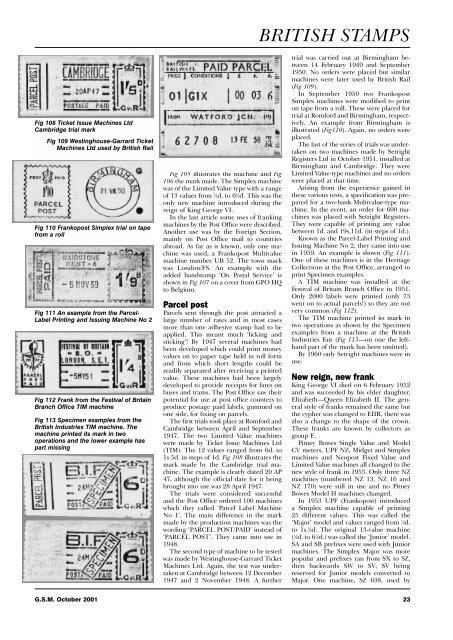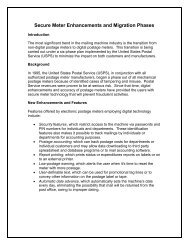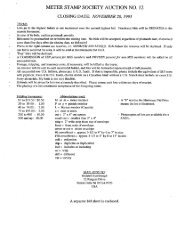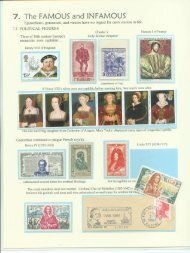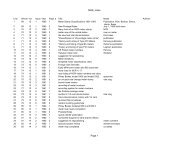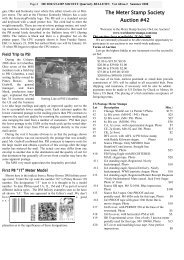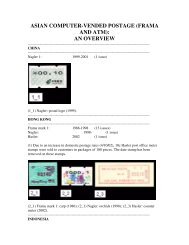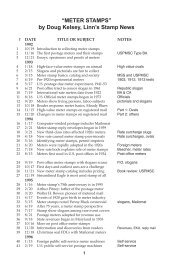GB Meter Franking - The Meter Stamp Society
GB Meter Franking - The Meter Stamp Society
GB Meter Franking - The Meter Stamp Society
Create successful ePaper yourself
Turn your PDF publications into a flip-book with our unique Google optimized e-Paper software.
BRITISH STAMPS<br />
Fig 108 Ticket Issue Machines Ltd<br />
Cambridge trial mark<br />
Fig 109 Westinghouse-Garrard Ticket<br />
Machines Ltd used by British Rail<br />
Fig 110 Frankopost Simplex trial on tape<br />
from a roll<br />
Fig 111 An example from the Parcel-<br />
Label Printing and Issuing Machine No 2<br />
Fig 112 Frank from the Festival of Britain<br />
Branch Office TIM machine<br />
Fig 113 Specimen examples from the<br />
British Industries TIM machine. <strong>The</strong><br />
machine printed its mark in two<br />
operations and the lower example has<br />
part missing<br />
Fig 105 illustrates the machine and Fig<br />
106 the mark made. <strong>The</strong> Simplex machine<br />
was of the Limited Value type with a range<br />
of 13 values from 1 ⁄2d. to 6 1 ⁄2d. This was the<br />
only new machine introduced during the<br />
reign of King George VI.<br />
In the last article some uses of franking<br />
machines by the Post Office were described.<br />
Another use was by the Foreign Section,<br />
mainly on Post Office mail to countries<br />
abroad. As far as is known, only one machine<br />
was used, a Frankopost Multivalue<br />
machine number UB 52. <strong>The</strong> town mark<br />
was London/FS. An example with the<br />
added handstamp ‘On Postal Service’ is<br />
shown in Fig 107 on a cover from GPO HQ<br />
to Belgium.<br />
Parcel post<br />
Parcels sent through the post attracted a<br />
large number of rates and in most cases<br />
more than one adhesive stamp had to be<br />
applied. This meant much ‘licking and<br />
sticking’! By 1947 several machines had<br />
been developed which could print money<br />
values on to paper tape held in roll form<br />
and from which short lengths could be<br />
readily separated after receiving a printed<br />
value. <strong>The</strong>se machines had been largely<br />
developed to provide receipts for fares on<br />
buses and trams. <strong>The</strong> Post Office saw their<br />
potential for use at post office counters to<br />
produce postage paid labels, gummed on<br />
one side, for fixing on parcels.<br />
<strong>The</strong> first trials took place at Romford and<br />
Cambridge between April and September<br />
1947. <strong>The</strong> two Limited Value machines<br />
were made by Ticket Issue Machines Ltd<br />
(TIM). <strong>The</strong> 12 values ranged from 6d. to<br />
1s.5d. in steps of 1d. Fig 108 illustrates the<br />
mark made by the Cambridge trial machine.<br />
<strong>The</strong> example is clearly dated 20 AP<br />
47, although the official date for it being<br />
brought into use was 28 April 1947.<br />
<strong>The</strong> trials were considered successful<br />
and the Post Office ordered 100 machines<br />
which they called ‘Parcel Label Machine<br />
No 1’. <strong>The</strong> main difference in the mark<br />
made by the production machines was the<br />
wording ‘PARCEL POST/PAID’ instead of<br />
‘PARCEL POST’. <strong>The</strong>y came into use in<br />
1948.<br />
<strong>The</strong> second type of machine to be tested<br />
was made by Westinghouse-Garrard Ticket<br />
Machines Ltd. Again, the test was undertaken<br />
at Cambridge between 12 December<br />
1947 and 2 November 1948. A further<br />
trial was carried out at Birmingham between<br />
14 February 1949 and September<br />
1950. No orders were placed but similar<br />
machines were later used by British Rail<br />
(Fig 109).<br />
In September 1950 two Frankopost<br />
Simplex machines were modified to print<br />
on tape from a roll. <strong>The</strong>se were placed for<br />
trial at Romford and Birmingham, respectively.<br />
An example from Birmingham is<br />
illustrated (Fig110). Again, no orders were<br />
placed.<br />
<strong>The</strong> last of the series of trials was undertaken<br />
on two machines made by Setright<br />
Registers Ltd in October 1951, installed at<br />
Birmingham and Cambridge. <strong>The</strong>y were<br />
Limited Value-type machines and no orders<br />
were placed at that time.<br />
Arising from the experience gained in<br />
these various tests, a specification was prepared<br />
for a two-bank Multivalue-type machine.<br />
In the event, an order for 600 machines<br />
was placed with Setright Registers.<br />
<strong>The</strong>y were capable of printing any value<br />
between 1d. and 19s.11d. (in steps of 1d.).<br />
Known as the Parcel-Label Printing and<br />
Issuing Machine No 2, they came into use<br />
in 1959. An example is shown (Fig 111).<br />
One of these machines is in the Heritage<br />
Collections at the Post Office, arranged to<br />
print Specimen examples.<br />
A TIM machine was installed at the<br />
Festival of Britain Branch Office in 1951.<br />
Only 2000 labels were printed (only 73<br />
went on to actual parcels!) so they are not<br />
very common (Fig 112).<br />
<strong>The</strong> TIM machine printed its mark in<br />
two operations as shown by the Specimen<br />
examples from a machine at the British<br />
Industries Fair (Fig 113—on one the lefthand<br />
part of the mark has been omitted).<br />
By 1960 only Setright machines were in<br />
use.<br />
New reign, new frank<br />
King George VI died on 6 February 1952<br />
and was succeeded by his elder daughter,<br />
Elizabeth—Queen Elizabeth II. <strong>The</strong> general<br />
style of franks remained the same but<br />
the cypher was changed to EIIR, there was<br />
also a change to the shape of the crown.<br />
<strong>The</strong>se franks are known by collectors as<br />
group E.<br />
Pitney Bowes Single Value and Model<br />
CV meters, UPF NZ, Midget and Simplex<br />
machines and Neopost Fixed Value and<br />
Limited Value machines all changed to the<br />
new style of frank in 1953. Only three NZ<br />
machines (numbered NZ 13, NZ 16 and<br />
NZ 170) were still in use and no Pitney<br />
Bowes Model H machines changed.<br />
In 1953 UPF (Frankopost) introduced<br />
a Simplex machine capable of printing<br />
25 different values. This was called the<br />
‘Major’ model and values ranged from 1 ⁄2d.<br />
to 1s. 1 ⁄2d. <strong>The</strong> original 13-value machine<br />
( 1 ⁄2d. to 6 1 ⁄2d.) was called the ‘Junior’ model.<br />
SA and SB prefixes were used with Junior<br />
machines. <strong>The</strong> Simplex Major was more<br />
popular and prefixes ran from SX to SZ,<br />
then backwards SW to SV; SV being<br />
reserved for Junior models converted to<br />
Major. One machine, SZ 638, used by<br />
G.S.M. October 2001 23


